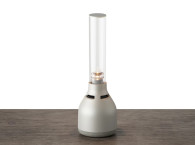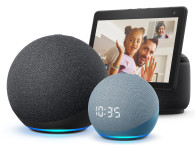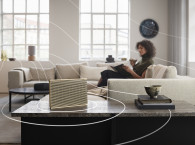One of the most intriguing concepts in speaker design is the notion that people have to sit in a very limited sweet spot - a carefully triangulated arrangement of a center line between our ears and the point source in a pair of speakers. For many music and audio enthusiasts, there's no other way - and preferably in a carefully treated listening environment designed for musical enjoyment. But what the market once dubbed as "living room stereo" is something that the vast majority of people completely ignore. Why would you even have to sit still to listen to music?

In the never-ending journey to understand and translate people's lifestyles into their designs, for years, multiple brands played around with integrated concepts that could be freely positioned. Those included trying to generate an expansive stereo image from a single-source system - for which, in fact, the original tube radios, TVs, and even the first portable stereo music systems in the 1950s were actually the inspiration.
Because people live with music and sound, and don't necessarily want to sit still when listening to speakers (who "listens" to speakers?), the notion of omnidirectional radiating designs, or 360-degree sound was in many speaker designers' minds and is always a recurring thought for many product strategists and not necessarily acoustic engineers. One way or another, omnidirectional speakers stayed in the market, without ever being a wining concept.

Smartest Speakers
Until one day, wireless audio and streaming made it possible to place speakers anywhere we like, and those actually started selling in significant numbers. Shortly after Sonos and its ecosystem of wireless multiroom audio, Bluetooth portable speakers and eventually smart speakers made a strong appearance.
Suddenly, small "hockey puck" and cylindrical-shaped Amazon Echos and spherical Google things started selling in the millions of units per year - now becoming a dominant category in home audio.
At first, the notion of pairing two of those speakers to generate a stereo system was meaningless (and also not technically feasible), which contributed to the fact that many millions of homes and many more millions of users today are perfectly comfortable with the notion of having a single speaker as their source for music.
This represents a strong dilemma for speaker designers. How should they address directivity in these designs? And is 360- degree dispersion even possible
Actually, the smartest of speakers that addressed all these questions was introduced in 2015 by the longest enduring of the Danish audio loudspeaker companies, Bang & Olufsen (B&O). In celebration of its 90th anniversary, Bang Olufsen introduced the revolutionary BeoLab 90 - also its most ambitious loudspeaker ever.
At the time, I met Bang & Olufsen's Geoff Martin, who was responsible for the project, and he explained how the company approached the development of active directivity control in the Beolab 90 in multiple ways.
The Beolab 90 features Beam Width Control capability, which enables it to change the width of the sound beam to suit different listening situations, from a dedicated sweet spot to a "party all over the room" setting - at the touch of a button. And the Beam Direction Control could be used to steer the sound radiation to cover any listening positions/location.

Among its many unique features, it also combines multichannel Active Room Compensation (a measurement microphone is included with each speaker) with resonance detection, Adaptive Bass Linearization, thermal compression compensation, and thermal protection, so the sound remains relatively unaffected by any environmental fluctuations. In terms of connectivity, it’s also worth noting that the BeoLab 90 already supported multichannel digital audio (24-bit/96kHz) wireless streaming based on the WiSA (www.wisaassociation.org) technology, apart from supporting also wired digital connectivity – a true reference and inspiration for the industry, in my opinion.
Typically, the process of developing a new B&O loudspeaker follows a standard timeline, refined over decades of creating active loudspeakers. But, the development of the Beolab 90 was different, integrating technologies that had been used on many earlier B&O loudspeakers and others that were completely new to the development team. The Beolab 90 was not (unfortunately) for everyone, but it certainly has created a new foundation for the brand.

With its unique design resulting also from the work of Frackenpohl and Poulheim studio in Koln, Germany, the impressive 137kg Beolab 90 “intelligent loudspeaker” is also a true monument to speaker design with its unique approach to accurate sound staging and exceptional flexibility in room adaptation and placement. As B&O states, it “may well be, the most complete and powerful digital loudspeaker ever designed for use in the home.”
It certainly was a strong departure for many other Beolab, Beosound, and Beoplay Loudspeakers from the brand, with unit prices from $250 to $100,000. I am certain some single Beolab speakers were sold and that its owners are perfectly happy with its omnidirectional "party mode" and the fact that its sound can be customized for any situation.
When I decided to write about this specific topic of speaker design, I had in mind "situational" scenarios. Because there are many usages for speakers that are not at all the typical "living room stereo" setting. Actually, judging by the number of new speaker designs we see increasingly in the show floor at CES and even on crowdfunding websites, brands are betting on consumers listening to music from single omnidirectional sources.
Amazon is all-in on the concept, as its Echo Studio model shows, going as far as supporting the ability to generate new immersive three-dimensional (3D) audio experiences and promote specific object-based spatial audio source formats (Dolby Digital, MPEG-H Audio, and Sony 360 Reality Audio) - which it doesn't.
Apple certainly thinks this will be a trend. Its HomePod can be paired and even grouped in multiples, but it was designed to be an outstanding single speaker source. And the new Apple HomePod mini validates that concept.

Washing Sounds
But there are other - even more radical - situational concepts for single speakers. I have recently followed a Kickstarter project called The Hydropower Shower Speaker that claims to be a 360-degree immersive and "bold sound source"... for your shower.
But a speaker that is actually designed to be placed in the shower - competing with the sounds of the water, is a bit beyond my notion of what would be even remotely interesting. As the fact that the hydropower Bluetooth shower speaker is "made from 100% recycled ocean plastic," fits any showerhead, and claims to generate 360-degree immersive sound...
Anyway, the Kickstarter project is fully funded, which means that its creators will eventually have to make and ship some (estimated MSRP $99.95).
I always heard about people who like to sing in the shower, and I can even understand the everlasting category of bathroom radios and similar gadgets for those busy people who like to start their mornings by following their favorite shows and listening to the morning news. I guess that's where most earlier-generation Amazon Echos are being used (some interesting sounds must be stored in Amazon Alexa's servers).
The Hydropower Shower Speaker patent-pending design "radiates evenly in all directions" and is also designed to sync with any Bluetooth-enabled device so users are able to listen to their favorite music, podcasts, or audiobooks, as soon as they turn on the water. And the company behind the design (Ampere) actually hired speaker designers with experience in portable speakers for brands such as Monster and Braven.

Interestingly, this speaker is powered by the actual water flow in the shower, so it remains always charged and never needs to be removed. With a fully charged battery, the Shower Power offers more than 16 hours of listening time and comes with a waterproof remote control, so users can change the playlist mid-shampoo rinse.
And if you think this an unusual idea, think twice because we had actually seen a similar concept at CES 2020, which recently made it to market. Kohler, a leading brand in smart kitchen and bath products, in partnership with Harman Kardon, announced the commercial launch of the new Kohler Moxie showerhead + wireless speaker ($179.99 in Polished Chrome finish or $199.99 in Matte Black or Vibrant Brushed Nickel).
The Kohler Moxie is marketed for "audio and bath enthusiasts seeking a connected experience in the bathroom," and is available with either a portable Bluetooth-enabled speaker or smart speaker with embedded Amazon Alexa. A "new audio and water experience to the showering space," the Moxie speaker comes certified with "the highest quality sound experience via Harman Kardon" and delivers "specialized tuning for the unique acoustic dynamics of the bathroom."

So, no need to take your old Amazon Echo to the ensuite every morning, since the Kohler Moxie comes with Amazon Alexa integrated, so users can "play music, check the news, order more shampoo, set timers, and control your smart products all hands-free, and without your phone."
Glass and Light
Getting out of the bathroom, single-source speakers are now being pitched to be placed anywhere in the house, in the patio, even as a table centerpiece for dinner parties. Just recently, audioXpress reported on the fact that the Sony LSPX-S2 Glass Sound Speaker is now available in the United States.
After the concept was successfully tested in Japan and Europe, this unique and elegant portable home speaker combines a unique sound with calming ambient illumination. Its glass cylinder combines with an aluminum base that evokes old gas fixtures, where a single 35mm driver generates an omnidirectional sound, enhanced by the vibrations resonating in the glass structure and a passive radiator on the base to provide the low-end notes. It’s a combination of a unique speaker design, attractive for the ingenious use of glass and the combination of a flickering LED light source, perfect to set a warming mood for romantic moods or a family event. And yes, Sony also suggest taking the LSPX-S2 to the bathroom...

So, I was not surprised when Kickstarter recently recommended a new portable Bluetooth speaker inspired by a traditional lantern, called the Light Speaker. Designed by Transparent, a Swedish company, the design was inspired by a traditional lantern and the light "feels like a real flame, glowing together with music."
The Light Speaker is described as able to generate "a big, open, omnidirectional sound delivering rich bass, stable mid tones and crisp high notes." The dome-shaped enclosure on the top holds a 2.5" full-range driver sending out 360-degree sound, while at the base of a solid borosilicate glass cylinder, creating a sealed valve, is a passive 3” woofer sitting in the bottom. And the design is completely modular, "designed so that any component can be removed, repaired, or upgraded over time."

And, the Kickstarter campaign allowed me to secure a unit for $260, which seems to be fair for a Scandinavian product that is promised to be built to last (it already uses a Bluetooth 5 module, but Transparent probably made it replaceable), when compared with the Sony LSPX-S2 Glass Sound Speaker, which retails for $449.99.
The Light Speaker only has two separate knobs - one for light, and one for sound. As we turn up the brightness, the light appearance goes from a dark glowing ember to a living candle, and all the way up to a bright natural with light (3500 kelvin). Yes, we can also connect and pair two Light Speakers using Bluetooth, but why do it, when this is perfect to take with me anywhere, including to the bathroom, for a relaxing shower by candlelight? aX

This article was originally published in The Audio Voice newsletter, December10, 2020 (#319). Click to register to The Audio Voice






